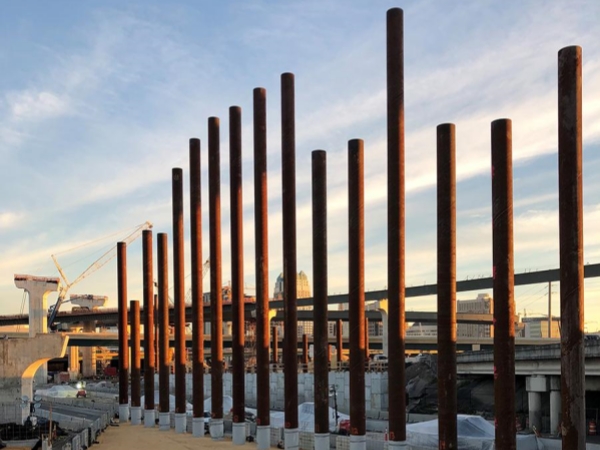Steel pipe piles are integral components in the construction of bridge pile foundations, offering advantages such as high bearing capacity, flexible piling, and rapid construction. In challenging terrains, steel pipe piles are particularly well-suited. In this article, we will talk about steel pipe pile common types and characteristics.

Common Types of Steel Piles:
- Closed End Pipe Piles:
These piles have a closed bottom and are often used in situations where soil or water conditions make it challenging to use an open-ended pile.
- Open End Pipe Piles:
Open-end pipe piles have an open bottom, allowing soil to enter the pipe during installation. They are commonly used in non-cohesive or granular soil conditions.
- End Plate Pipe Piles:
End plate pipe piles have a plate welded to the end of the pile, providing additional bearing capacity. This type is suitable for resisting large lateral loads.
- Screwed or Socketed Pipe Piles:
Screwed or socketed pipe piles have a socket at the end, which allows for easy connection to another pile or structural element. This type facilitates efficient construction and ensures proper alignment.
- Filler Pipe Piles:
Filler pipe piles have a cavity in the center, allowing for the injection of concrete or grout. This type enhances the pile's load-carrying capacity and provides additional stability.
- Floating Pipe Piles:
Floating pipe piles are hollow and can be filled with materials to control buoyancy during installation. They are often used in marine construction or areas with high groundwater tables.
Characteristics of Steel Pipe Piles:
- Diverse Specifications:
The market offers a wide array of steel pipe pile specifications. Choosing the most suitable one is essential for leveraging the benefits of steel pipe piles while ensuring project safety, gender, and economic imperatives.
- Strong Bearing Capacity:
Most steel pipe piles in current project construction use low carbon steel. This material exhibits robust strength, tension, and compression characteristics. The processed steel pipes offer high bending resistance, making them suitable for geological environments with robust load-bearing layers.
- Adjustable Pile Length and Economic Efficiency:
Conventional steel pipe pile lengths are typically 6m, and adjustments can be made during welding or cutting processes based on changes in the burial depth of the bearing layer. The cut-off portions can be repurposed, minimizing resource waste. Accurate control of the pile top elevation enhances construction efficiency.
- Slight Soil Compaction:
Steel pipe piles, primarily open-type, feature thin walls, reducing the disturbance to topsoil and squeezed soil. This minimizes the impact of pile pressing on the soil and surrounding facilities. Additionally, the construction of steel pipe piles can be concentrated in a small area.
In summary, steel pipe piles offer a versatile and efficient solution for foundation construction, providing adaptability to various terrains and ensuring cost-effective and environmentally conscious construction practices.